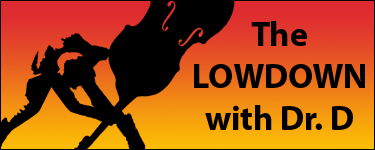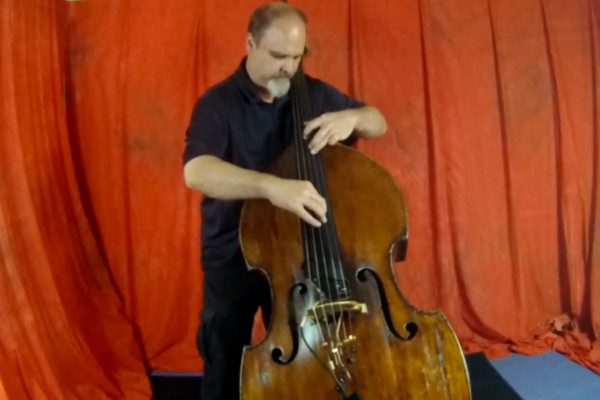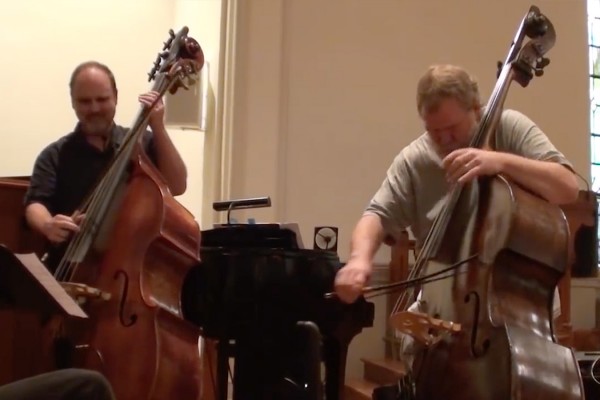The Lowdown with Dr. D.: Making the Switch from Electric to Upright (part 3 of 3)

The Left Hand
Contrary to what many of us expect when we hop on over from Electric, effective and reliable left hand technique can be one of our more formidable challenges as a switcher. We will be learning a new way to use our left hand on an instrument that seems so similar to one we already know, but is not quite the same. Despite the similarities of the two instruments and their techniques, the foundational techniques are different, and at the outset of our journey, it can present a challenge.
There are many reasons the foundational left hand techniques of these two cousins are different, but the most obvious reason is the string length. [note: ***The standard Upright bass is a ¾ size instrument, not a “full size.” Most basses you will come across are ¾, not “full size”]. Unless you are playing a short scale electric upright, the string length on your Upright will be much longer than you are used to. The average string length for an upright is 41.25-42” (approx. 105-106.5 cm) but it can go all the way up to around 44“. Compare this to the friendly 34” Electric, and you begin to see the issue.
Never fear! Ultimately, your Electric technique will be a valuable asset, and not a liability. Your previous experience will certainly help to propel you forward. You just need to set your new foundation on your new instrument first.
A longer string length means the notes are further apart, which will affect our reach. Additional precision (no frets!) and increased pressure,to press the strings down, is also required. If we are not careful, this combination can give us bad intonation and damaged hands. To combat this, I suggest a 1-2-4 fingering system (the outer fingers encompassing two half steps, or three “frets”) as you begin your Upright journey. As it turns out, this is the longest standing, most established traditional approach to fingering on the Upright. Those who have watched my left hand, sometimes ask why I suggest such a traditional approach for them, when I use a larger bag of tricks.
I have numerous reasons for my position, and there is an entire chapter on this in my upcoming book (due out Fall 2010) which goes into great detail as to why. Simply put, I have seen, used and studied many left hand techniques, and experienced their practical results as a student and teacher. This experience and study has convinced me that the traditional 1-2-4 fingering system provides the most reliable and solid foundation. We want to establish a solid foundation now so we won’t have to go back and fix it later. Don’t worry, if you do it right, you will be pivoting, using 1-2-3-4, “open hand,” “crab,” and 5 finger systems soon enough.
Intonation
If you are used to playing on a fretted instrument, you will likely struggle with intonational swill in the early stages of your Upright playing. In addition to improving your physical accuracy, you likely need to refine your fine pitch discrimination to detect the smallest discrepancies. With attention, both skills will improve over time. Here are some quick suggestions to get you on your way:
1. Get private instruction now. I can’t stress enough how important it is that your early forays into Upright technique give you a proper foundation. There are tons of books and videos out there, and you should certainly seek them out, but nothing compares to one-to-one instruction from a master of the instrument. Find a reputable teacher and study regularly with them. I will talk more about what to look for, and what to avoid, in a bass teacher in a future installment.
Again, go with a teacher who will provide you with instruction in the 1-2-4 (Simandl/Nanny) fingering system as a foundation. If you can’t find the kind of teacher you want locally, Video Chat lessons offer the ability to study with people from around the world. It is one of my favorite ways to teach.
2. As soon as you are able, begin practicing with the bow, even if you never plan to use it on stage. It is an essential tool for securing your intonation. Ray Brown did it, so should you.
3. Practice your scales and riffs slowly with a drone playing in the background. The root of the scale/key works well.
4. Put “fret markers” on your fingerboard. I can hear the traditionalists squirming and murmuring now. Do it anyway. Most of the objections to markers are rooted in Machismo and misplaced Ego. You have a lot of fingerboard to navigate and any edge you can get in the quest for accurate intonation is worth using. There are temporary and permanent options. I advise making it permanent.
A small gauge sterling silver wire drilled into the fingerboard provides your best option. This creates a “dot” which can be seen in all lighting situations, and is not readily apparent from a distance. This means you can use it to improve your intonation without being forced to endure ignorant comments or looks of disdain from other string players….other people (like trumpet players, drummers and audience members) won’t care.
Bottom line: Markings help. Use them. You get paid to play in tune.
5. Stay loose, it will help your accuracy. Remember: Unneeded tension is our enemy.
6. Listen! Developing a refined ear is a process, so take every opportunity to improve your ear. Refined pitch discrimination is a subject all to itself, and a journey. Work at it everyday. Read about temperament and intonation. Pick an ear training program and wear it out. Then do another. Listen, listen, listen…and then listen more deeply.
Dr. Donovan Stokes is on the faculty of Shenandoah University-Conservatory. Visit him online at www.donovanstokes.com and check out the Bass Coalition at www.basscoalition.com.




Hey Donovan-
Thanks very much for your very useful column.
There is one point it contains that I disagree with, which is OK, everybody has a point of view, nothing personal or no disrespect intended.
I am in the camp that is opposed to the usage of permanent visual aids such as embedded markers on the instrument. I have another reason for it than your postulated “machismo” or ego for this opinion, but it is instead rooted in neurological research from the last 20 or so years. I have a column here on notreble, and one of the episodes “Practicing and the Mind” http://www.notreble.com/buzz/2009/08/31/lesson-… talks about this research and the conclusions drawn from it…
Although visual cues are very useful in the earliest stages of learning (and these cues can be achieved using chalk or a cutout piece of paper taped to the neck of the bass), the placement of permanent markers will tend to foster a habit of dependence upon them on the part of the player. As we learn the fingerboard, we actually learn the “feel” of the location of the notes, and we control intonation by the SOUND of the note. If one is visually dependent, how is it possible to play in tune while reading a piece of music, for example?
The sooner that the player is weaned from visual cues, the better – for overall performance as well as accuracy in pitch. Playing in tune is ultimately a matter of intention – and attention – to SOUND – not visual cues.
“Music is sound and feeling.” – Milt Jackson
Just my opinion…
Given all the instruments you see, what percentage of them have dots on them? Good question to ponder…
Best,
Jon
Hi Jon,
Thanks for your thoughts, I welcome all comments! Glad to see you here on notreble.com!
Even though our conclusions are different, I can tell that you have put a lot of thought into your pedagogical opinions on the use of visual cues. This tells me that you do NOT fall into the “Machismo” or “Ego” camp. You are clearly a thinking teacher and player, which can only be applauded! Keep it up! We need more like you!
Perhaps, I wasn't clear in my column above, but of course (!) people should still listen and feel as they play. These are important components of being an instrumentalist and a musician.
As for fingerboard markers themselves, I could go on and on about why they are a good idea, and I do a bit in my upcoming book. In it, there is a good deal addressing your final question “to ponder” regarding visual cues (or apparent lack thereof) on other stringed instruments and how that relates to our situation as Upright Bassists. I have studied in depth the pedagogy of some of those instruments and discovered a number of things …but I don't want my comments here to be longer than the original column!!
For now:
I know not everyone agrees, but my experience has been that “markers” are helpful, for all stages of player, in a variety of musical and “real world” situations, and in many, many more ways.
Although I ponder, research and deliberate about my teaching and playing, I am at heart a pragmatist. This heavily influences how I approach the bass, especially as a teacher. In this regard, I have not seen anyone play with worse intonation after having placed markers on the fingerboard. I have, however, seen them improve their intonational acuity.
As I mentioned above, we still must listen and feel. Certainly the intonation of Edgar Meyer, who has big 'ol inlays on his fingerboard, couldn't be called into question. He listens, feels…and sees. One sense helps the other, to his (and the listener’s) great benefit.
That doesn't mean markers are for everyone, anymore than everyone should play with a bent endpin, sit on a stool, or play German bow. Nonetheless, I find them to be a “balance positive” tool for us to use. I still advise them, and use them.
Yours in bass!
D
Hi Donovan, Very nice article with a lot of good ideas. I would have to agree with Jon Burr that markers on the fingerboard might ultimately cause more problems than they solve. Edgar Meyer and a few players do have certain position markers, but I would guess that they did not start with them as beginning students. Ray Brown, who you also reference, never used markers. I don't use them, and most all the players I know do not use them. As Jon wrote, it's more about using the feel and the sound of the notes. There are actually a lot of visual landmarks up and down the fingerboard without having to add anything extra.
Also just my 2 cents worth — I am sure you've given this a lot of thought and that it works well for you and your students.
So, thanks for your thoughtful post. I look forward to checking out your book when it comes out.
Hi John, I often suggest your book “The Jazz Bass Book” to my jazz students. Thank for compiling it, I love it. Thanks also for commenting here.
I have found that many beginning students actually start with markers (often in the form of tape) and then remove them as they progress. This includes cellists and violinists, as well as bassists. It is used primarily as a physical training tool. They even sell enough of it for stores to package and sell it as “fingerboard tape.”
Although I suggest it for everyone, and know many players who use markings (I stole the silver wire trick from a Vegas pit player), I think they are particularly valuable for Electric switchers. They give a visual reference for the new note spacing on the Upright. This saves a great deal of time, pedagogically speaking. Of course, one still must use proprioception and listen. Here we seem to concur!
Thanks for your thoughtful comments!
D
Thanks, Donovan. Well, whatever works is a good thing! I really like your other ideas about switching from E- to Double Bass. Keep up the good work.
And thanks for the nice words about the Jazz Bass Book. I also have a new edition of Jazz Bowing Techniques for the Improvising Bassist out at
http://aebersold.com/Merchant2/merchant.mvc?Scr…
This book has lots of intonation exercises, related to learning jazz bowing. Just a plug ;-)
Thanks, Donovan. Well, whatever works is a good thing! I really like your other ideas about switching from E- to Double Bass. Keep up the good work.
And thanks for the nice words about the Jazz Bass Book. I also have a new edition of Jazz Bowing Techniques for the Improvising Bassist out at
http://aebersold.com/Merchant2/merchant.mvc?Scr…
This book has lots of intonation exercises, related to learning jazz bowing. Just a plug ;-)
Did Ray Brown use Drones?